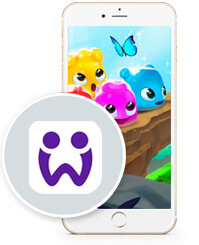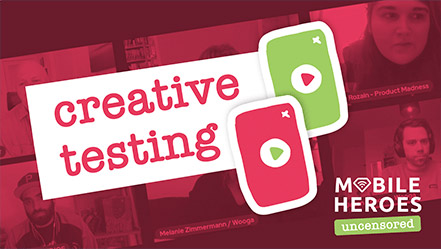Q&A with Melanie
Melanie Zimmermann is Head of Marketing at Wooga, where she leads a team of professionals for various story-driven casual mobile games. With over twenty years of experience in the creative industry and ten years in gaming, Melanie merges the best of marketing PC games and mobile. Before Wooga, Melanie held impressive roles as Head of Design at Disney Interactive (Club Penguin) and as Creative Director at Riot Games (League of Legends). In 2018, Melanie joined the Berlin-based mobile gaming publisher, eager to bring her pizazz and know-how to their games.
Read Melanie's latest article: "Why Developing a Strong Brand Is Important for Your Business"
In your own words, tell us about the app(s) that you manage?
Wooga leads the market for Hidden Object Games. It is our mission to captivate players with an immersive storyline and relaxing yet challenging gameplay. Our games are of high production value and made to be on devices for years.
Strong community management and marketing campaigns that aim to engage and deliver value to players support our game portfolio. For this strategy to work, product and marketing collaborate closely together. You also need to invest in understanding your players. All this sets us up for success, particularly June's Journey and Pearl's Peril (which turns eight years old in March—a considerable achievement in the mobile games space).
As Head of Marketing, I lead a team of incredibly talented people with different skills and seniority levels. This includes Marketing Managers for advertising and product marketing, CRM Managers, Community Managers and a Creative Production Team. I am also responsible for Brand Development at Wooga.
How did you get started in mobile marketing?
I have been working in the games industry for more than ten years, with the first years spent working for PC games (Club Penguin and League of Legends). A few years back, Wooga reached out to see if I'd be up for joining their Publishing Team—I was ecstatic about the opportunity.
What do you like most about mobile marketing?
Mobile marketing never stops. It uses various channels, is fast-paced, results-driven, and always something new to test and learn. You see results quickly and adapt tactics accordingly. Use this to your advantage while having flexible strategies. When I first joined Wooga, I was excited for the opportunity to merge my experience from the PC games space with mobile games marketing practices to create something new and unique.
What does it take to succeed in mobile marketing?
You always have to be on top of things. Know your industry, competitors and trends. Being naturally curious and passionate about driving things forward helps. Who is our audience? What do they need and why?
Who are we? Who do we want to be and why? Why does what we do matter? Learning about your users and knowing yourself as a brand is equally important. Actively building a strong brand is essential to avoid falling into the many traps of damaging your strategy when things get challenging. Challenges like a product reaching saturation with its "obvious users'' and no longer growing using a direct marketing channel, or a team looking for quick wins over sustainable growth. A strong brand will also help you make decisions when it comes to innovation and product development.
What strategies work best to convert installs into engaged app users?
Converting installs into engaged app users is when the fun part of the job starts.
Like I already mentioned, you want to know who your users are and what they are looking for when interacting with your app. Develop strategies and content for them. Only then can you deliver real value.
The other pillar is developing a strong brand strategy, which gets translated into aligned tactics on your various marketing channels.
Both pillars combined will act as the foundation for user engagement, retention and loyalty.
Last but not least, be authentic. Keep your users engaged and excited, listen to their feedback, be innovative and surprise them. Your social media and CRM channels are great channels for this.
What advice can you offer marketers to successfully re-engage mobile app users?
From a brand standpoint, find ways to remind users why they loved your app in the first place. Also, why did they leave? What do they see in a competitors' app that is missing from yours? Can you offer new features to re-engage churned users? Have you thought about investing in channels like CRM to provide a customized experience for different user profiles? Also, how do you reach them and what message is most likely to attract them back?
My best advice is to actively search for user-feedback via dialogue and keep a close eye on industry trends before your users churn.
What’s your top tip when it comes to mobile ad creative?
- Be true to your brand and align on brand identity across marketing channels. E.g., for June's Journey’s visuals, two things are imperative: high-quality assets and the specific look of the 1920s.
- Within the boundaries of your brand, never stop testing. Depending on your results, some changes are needed to correspond with your guiding principles. Always analyze why things perform well versus don’t.
- Know how to implement trends without blindly following them. Do not try to mislead people. E.g., the trend of “fake ads” was never an option for Wooga.
- Have brand guidelines define your visual brand identity—especially if you are outsourcing creatives.
What are your top 3 go-to resources for keeping up with the mobile ad tech industry?
- Catching up with others in the industry is my favorite way of exchanging learnings.
- Follow industry leaders and influencers on various apps for hot topics and trends.
- Stay updated with newsletters and websites from the broader marketing, games and creative spaces.
























